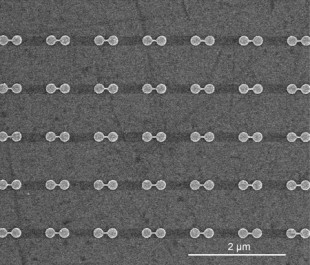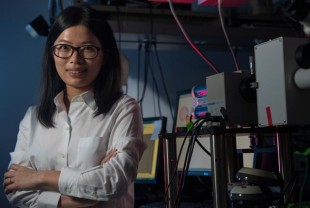David Ruth
713-348-6327
david@rice.edu
Jade Boyd
713-348-6778
jadeboyd@rice.edu
Rice researchers make ultrasensitive conductivity measurements
Photonic platform could provide ‘optical signatures’ for molecular electronics
HOUSTON — (June 10, 2015) — Researchers at Rice University have discovered a new way to make ultrasensitive conductivity measurements at optical frequencies on high-speed nanoscale electronic components.
The research at Rice’s Laboratory for Nanophotonics (LANP) is described online in a new study in the American Chemical Society’s journal ACS Nano. In a series of experiments, LANP researchers linked pairs of puck-shaped metal nanodisks with metallic nanowires and showed how the flow of current at optical frequencies through the nanowires produced “charge transfer plasmons” with unique optical signatures.

The animation shows how a "charge transfer plasmon" oscillates between linked nano disks. Credit: Yue Zhang/Rice University
“The push to continually increase the speed of microchip components has researchers looking at nanoscale devices and components that operate at optical frequencies for next-generation electronics,” said LANP Director Naomi Halas, the lead scientist on the study. “It is not well-known how these materials and components operate at extremely high frequencies of light, and LANP’s new technique provides a way to measure the electrical transport properties of nanomaterials and structures at these extremely high frequencies.”
Halas is Rice’s Stanley C. Moore Professor of Electrical and Computer Engineering and professor of chemistry, bioengineering, physics and astronomy, and materials science and nanoengineering. Her lab specializes in the study of nanoparticles that interact with light. For example, some metallic nanoparticles convert light into plasmons, waves of electrons that flow like a fluid across the particle’s surface. In dozens of studies over the past two decades, LANP researchers have explored the basic physics of plasmonics and shown how plasmonic interactions can be harnessed for applications as diverse as medical diagnostics, cancer treatment, solar-energy collection and optical computing.
One type of plasmonic interaction that Halas’ team has long studied is plasmonic coupling, a kind of interacting dance that plasmons engage in when two or more plasmonic particles are located near one another. For instance, when two puck-shaped plasmonic nanodisks are located near one another, they act like a tiny, light-activated capacitor. When a conducting wire is used to bridge the two, their plasmon energies change and a new resonance called a “charge transfer” plasmon, appears at a distinct frequency.
In the new research, study lead author Fangfang Wen, a Rice graduate student at LANP, examined the optical properties of pairs of bridged nanodisks . When she created plasmons in the pairs, she observed the charge flowing back and forth along the wires at optical frequencies. In examining the charge transfer plasmons in these pairs, she discovered that the electrical current flowing across the junction introduced a characteristic optical signature.
“In the case where a conducting wire was present in the junction, we saw an optical signature that was very different from the case without a wire,” Wen said. Wen then set up a series of experiments where she varied the width and shape of the bridging nanowires and repeated these measurements for nanowires of two different metals, gold and aluminum.

This artist's rendering depicts a pair of gold nanodisks linked by a gold bridge. Credit: Fangfang Wen/Rice University
These experiments revealed two key findings. First, at the low end of the conductance scale, she found that even the slightest changes in conductivity resulted in notable optical shifts — a finding that could be particularly interesting for molecular-electronics researchers who are interested in measuring conductivity in structures as small as a single molecule.
“We also found that our platform gave a different optical signature in cases where the level of conductance was the same but the junction material was different,” Wen said. “If we had nanowires with the same conductance that were made of different materials, we saw a different optical signature. If we used the same material, with different geometries, we saw the same signature.”
This specificity and repeatability could also be useful to researchers who might want to use this approach to identify the conductance of nanowires, or other nanoscale electronic components, at optical frequencies. “The optical frequency conductance of most materials is not known,” she said. “This provides a useful and practical method to measure this property.

Linked pairs of nanodisks as seen with a scanning electron microscope. Credit: Fangfang Wen/Rice University
“To reduce the size of electronics even beyond today’s limits, scientists want to study electron transfer through a single molecule, particularly at extremely high, even optical frequencies,” Wen said. “Such changes cannot be measured using standard electronic devices or instruments that operate at microwave frequencies. Our research provides a new platform for the measurement of nanoscale conductance at optical frequencies.”
In recognition of the research’s potential to improve “people’s lives through the transforming power of chemistry,” the American Chemical Society made the paper an ACS Editors’ Choice and is making it freely available for public access online.
Study co-authors include Peter Nordlander, the Wiess Chair and Professor of Physics and Astronomy at Rice, and Rice graduate students Yue Zhang, Samuel Gottheim, Nicholas King and Yu Zhang. The research was supported by the Robert A. Welch Foundation, the Department of Defense’s National Security Science and Engineering Faculty Fellowship Program, the Defense Threat Reduction Agency, the Air Force Office of Scientific Research and the Army.
-30-
High-resolution IMAGES are available for download at:
https://news2.rice.edu/files/2015/06/CTP-mode-charge-animation1.gif
CAPTION: The animation shows how a “charge transfer plasmon” oscillates between linked nanodisks.
CREDIT: Yue Zhang/Rice University
https://news2.rice.edu/files/2015/06/0605_CHARGE-SEM1-lg.jpg
CAPTION: Linked pairs of nanodisks as seen with a scanning electron microscope.
CREDIT: Fangfang Wen/Rice University
https://news2.rice.edu/files/2015/06/0605_CHARGE-Dimer-lg.jpg
CAPTION: This artist’s rendering depicts a pair of gold nanodisks linked by a gold bridge.
CREDIT: Fangfang Wen/Rice University
https://news2.rice.edu/files/2015/06/060515_CHARGE-Wen-161-lg.jpg
CAPTION: Fangfang Wen
CREDIT: Jeff Fitlow/Rice University
A copy of the ACS Nano paper is available at:
http://pubs.acs.org/doi/abs/10.1021/acsnano.5b02087
Located on a 300-acre forested campus in Houston, Rice University is consistently ranked among the nation’s top 20 universities by U.S. News & World Report. Rice has highly respected schools of Architecture, Business, Continuing Studies, Engineering, Humanities, Music, Natural Sciences and Social Sciences and is home to the Baker Institute for Public Policy. With 3,888 undergraduates and 2,610 graduate students, Rice’s undergraduate student-to-faculty ratio is just over 6-to-1. Its residential college system builds close-knit communities and lifelong friendships, just one reason why Rice is highly ranked for best quality of life by the Princeton Review and for best value among private universities by Kiplinger’s Personal Finance. To read “What they’re saying about Rice,” go here.


